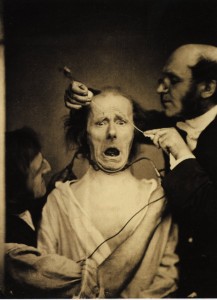By Juliet Wagner (Regular Contributor)
Most adults are adept at reading facial expressions. A smile communicates openness or mirth, and we can infer from photographs of human faces if the subject is shocked, for example, or experiencing disgust or sadness. Even in the nineteenth century, there was evidence that common facial expressions were universal, and not learned from mimicry. It is consequently unsurprising that many scientists of that period saw the human face as a window into the soul.
Physiognomy: The Analysis of the Facial Characteristics
For physiognomists, the face was the key to an individual’s personality and moral character. Charles Darwin’s half cousin, Sir Francis Galton, used composite images of faces to map character types, for example, and criminologists pored over early mugshots of convicts in order to delineate “criminal” measurements and proportions. For the doctor Guillaume Duchenne de Boulogne, however, the capacity of every human face to convey inner emotion was a more intriguing subject for research. He was interested not in what made faces remarkable and distinctive, but in the universal—and in his conviction, God-given—array of facial expressions.
Duchenne was an expert in theoretical and practical neurology, a discipline that he pioneered alongside his more famous colleague Jean-Martin Charcot, and his research on facial expression focused on the nerves that produced expressions. He wanted to understand the anatomical mechanisms whereby facial expressions were produced, and to do this, used electrical stimulation of particular muscles to reliably recreate them.
“The old man”
This well-known photograph shows Duchenne performing this experiment on a patient he called “the old man.” It is a startling photograph, because the horror on the man’s face seems to reflect back our own. The image looks simultaneously like torture and like an exquisite studio portrait, and the contrast is disquieting. When Duchenne explained his choice to use the new medium of photography on the grounds that it could produce an image “like a mirror”, he likely did not have this effect in mind. Duchenne was not insensitive to the apparent cruelty of his technique, however: he explained in the 1862 publication in which the photograph was printed that “the old man” suffered from an anesthetic condition of his face which prevented him from feeling pain. Nonetheless, the exposure time required to produce such a clear photograph in the 1860s was such that this cannot have been a comfortable procedure.
In 1862, this image represented both the most advanced neurological knowledge and the most groundbreaking visualization technology available. It makes one wonder whether, say, an MRI scan, might appear as bizarre and oddly fascinating a relic in 150 years.

